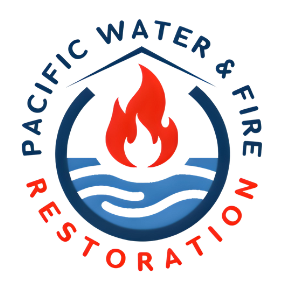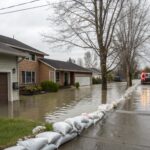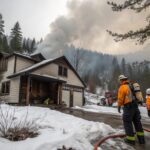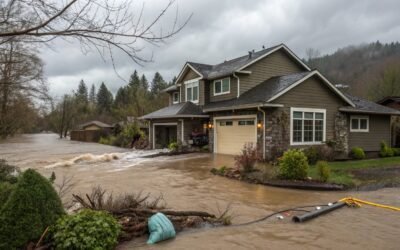In the beautiful Pacific Northwest, Beaverton residents enjoy stunning landscapes and a vibrant community. However, our region also faces its share of natural disasters—from winter storms and flooding to the potential for wildfires and even earthquakes. At Pacific Water & Fire Restoration, we’ve helped countless Portland metro area homeowners recover from disaster damage, and we’ve learned that preparation makes all the difference in how quickly and completely you can bounce back.
Understanding Beaverton’s Disaster Risks
Beaverton’s location in the Tualatin Valley means we face some specific natural disaster challenges:
- Winter Storms: Heavy rain, wind, and occasional ice storms can lead to power outages, flooding, and property damage.
- Flooding: The proximity to creeks and streams puts many neighborhoods at risk during heavy rainfall periods.
- Wildfire Smoke: While direct wildfires are less common in Beaverton proper, smoke from regional fires can affect air quality and infiltrate homes.
- Earthquake Risk: The Cascadia Subduction Zone poses a significant earthquake risk to the entire Portland metro area.
According to Oregon’s Office of Emergency Management, over 60% of homeowners in our region are underprepared for natural disasters, with many lacking basic emergency supplies or evacuation plans.
Creating Your Family Disaster Plan
Assess Your Specific Risks
Every Beaverton home has its unique risk profile based on location, construction, and surrounding environment.
Pro Tip: Walk your property during different seasons to identify potential hazards. Note areas where water pools during heavy rain, trees that could impact your home during windstorms, and potential entry points for wildfire smoke.
Build Your Emergency Kit
Your emergency kit should sustain your household for at least 72 hours. Include:
- Water (one gallon per person per day)
- Non-perishable food
- Medications and first aid supplies
- Flashlights and extra batteries
- Battery-powered or hand-crank radio
- Personal hygiene items
- Important documents in waterproof containers
- Cash in small denominations
- Pet supplies if applicable
For Beaverton residents, we also recommend including:
- Rain gear and warm clothing
- Water purification tablets (especially important if you’re near Beaverton’s watershed areas)
- N95 masks for wildfire smoke seasons
- Basic tools for emergency home repairs
Create a Communication Plan
When disaster strikes, communication networks may be compromised. Establish:
- A family meeting place in your neighborhood
- An out-of-area contact person everyone can call
- A plan for reuniting if separated during an emergency
- Knowledge of evacuation routes from your Beaverton neighborhood
Document Your Property
Before disaster strikes, thoroughly document your home and belongings:
- Take videos and photos of each room
- Create an inventory of valuable items with approximate values
- Store documentation in cloud storage and physically in a waterproof container
- Update documentation annually or after major purchases
This documentation will prove invaluable when filing insurance claims if disaster strikes.
Weather-Specific Preparation for Beaverton Homes
Winter Storm Readiness
Winter storms in Beaverton can bring heavy rain, wind, and occasionally ice, leading to power outages and property damage.
Preparation Steps:
- Clear gutters and downspouts before the rainy season
- Trim trees and branches that could fall on your home
- Inspect your roof for loose shingles or potential leaks
- Install weather stripping on doors and windows
- Insulate pipes to prevent freezing
- Know how to shut off your water at the main in case of pipe breaks
- Consider a backup power source like a generator
Safety Warning: Never use portable generators indoors or in garages. Carbon monoxide poisoning is a serious risk during power outages.
Flood Protection Measures
With Beaverton’s many creeks and streams, flooding is a real concern for many neighborhoods, particularly those near Fanno Creek or Beaverton Creek.
Flood-Proofing Steps:
- Evaluate your flood risk using FEMA’s flood maps for Washington County
- Consider flood insurance, even if not in a high-risk zone
- Install check valves in plumbing to prevent backups
- Elevate electrical systems, water heaters, and appliances in basements
- Keep sandbags on hand during rainy seasons
- Install sump pumps with battery backups
- Apply waterproofing compounds to foundation walls
Local Resource: Beaverton residents can access free sandbags during flood watches at several locations throughout the city, including the Beaverton Operations Facility.
Wildfire Smoke Mitigation
While direct wildfires are less common in Beaverton, smoke from regional fires can significantly impact air quality.
Smoke Protection Measures:
- Install high-efficiency air filters in your HVAC system (MERV 13 or higher)
- Create a designated clean room with portable air purifiers
- Seal doors and windows with weather stripping
- Keep N95 masks on hand for necessary outdoor activities
- Monitor air quality through Oregon DEQ’s website or app
Pro Tip: Consider installing a whole-house air filtration system if you have family members with respiratory conditions. While an investment, these systems can dramatically improve indoor air quality during smoke events that have become more common in recent years.
Earthquake Preparedness
The Cascadia Subduction Zone presents a significant earthquake risk to all Portland metro area residents, including Beaverton.
Earthquake Safety Steps:
- Secure heavy furniture and appliances to walls
- Install cabinet latches to prevent items from falling
- Know how to shut off utilities
- Identify safe spots in each room (under sturdy tables, against interior walls)
- Keep shoes and flashlights by beds
- Participate in earthquake drills with family members
Local Resource: Beaverton residents can participate in free earthquake preparedness workshops offered through the Community Emergency Response Team (CERT) program.
Creating a Disaster-Resistant Home
Beyond emergency planning, there are structural improvements that can make your Beaverton home more resilient to natural disasters.
Water Damage Prevention
Water damage is the most common disaster we respond to in Beaverton homes. Preventative measures include:
- Installing water leak detection systems
- Regular inspection of water appliances and connections
- Maintaining and cleaning gutters and downspouts
- Proper landscaping that directs water away from foundations
- Sealing basement walls with waterproofing compounds
- Installing a sump pump with battery backup
Fire-Resistant Home Improvements
While wildfires are less common in Beaverton proper, these improvements can protect against both wildfire risk and home fires:
- Installing fire-resistant roofing materials
- Using fire-resistant siding on exterior walls
- Enclosing eaves and vents with fine mesh to prevent ember entry
- Creating defensible space around your property
- Installing smoke and carbon monoxide detectors on every level
- Having fire extinguishers accessible throughout your home
Structural Reinforcements for Earthquakes
Earthquake retrofitting can significantly improve your home’s chance of surviving a major seismic event:
- Bolting the house to the foundation
- Reinforcing cripple walls
- Bracing water heaters
- Installing automatic gas shutoff valves
- Reinforcing masonry chimneys
- Addressing soft-story configurations in multi-level homes
Investment Insight: While these improvements require upfront investment, they can reduce insurance premiums and, more importantly, prevent catastrophic damage. According to FEMA, every $1 spent on hazard mitigation saves $6 in future disaster costs.
When Disaster Strikes: The First 24 Hours
Despite the best preparation, disasters can still impact your home. The first 24 hours are critical for minimizing damage and beginning recovery.
Safety First
- Ensure everyone’s physical safety before addressing property concerns
- Follow evacuation orders without hesitation
- Be alert for gas leaks, electrical hazards, and structural damage
- Use emergency supplies as needed
- Listen to local emergency broadcasts for instructions
Damage Assessment and Documentation
Once safety is established:
- Document all damage with photos and videos before attempting cleanup
- Contact your insurance company immediately
- Make only temporary repairs necessary to prevent further damage
- Keep all receipts for emergency expenses
- Avoid discarding damaged items until an insurance adjuster has seen them
Preventing Secondary Damage
Many property owners don’t realize that secondary damage can often exceed the initial disaster damage:
- Water Damage: Mold can begin growing within 24-48 hours
- Fire Damage: Soot and smoke continue to damage surfaces if not addressed
- Storm Damage: Exposed areas can lead to additional water intrusion
Professional Insight: From our experience serving Beaverton residents, we’ve found that professional intervention within the first 24 hours can reduce overall restoration costs by up to 40% by preventing secondary damage.
The Recovery Process: Working with Professionals
When to Call Professional Restoration Services
While minor damage might be manageable as a DIY project, certain situations demand professional intervention:
- Water damage affecting drywall, insulation, or large areas
- Any sewage backup or contaminated water
- Smoke or fire damage of any size
- Mold covering more than 10 square feet
- Structural damage to the home
- Situations requiring specialized equipment like industrial dehumidifiers, air scrubbers, or negative air machines
Professional restoration companies like Pacific Water & Fire Restoration have the equipment, expertise, and experience to safely and effectively restore your property.
What to Expect from Restoration Professionals
A reputable restoration company will follow a structured process:
- Emergency Response: Arrives quickly to assess the situation and prevent further damage
- Assessment and Documentation: Creates a detailed plan for restoration
- Water Removal and Drying: Uses professional equipment to extract water and thoroughly dry affected areas
- Cleaning and Sanitizing: Removes contaminants, soot, and odors
- Restoration and Repairs: Rebuilds damaged areas to pre-loss condition
Working with Insurance
Most homeowners find navigating insurance claims challenging during an already stressful time.
Pro Tip: Professional restoration companies can assist with insurance documentation, providing detailed damage reports, photos, and itemized restoration plans that speed up the claims process.
Key insurance steps include:
- Reporting the claim immediately
- Documenting all damage before cleanup
- Keeping all receipts for emergency repairs and displacement costs
- Understanding your policy coverage and limitations
- Being present during adjuster inspections
- Getting multiple repair estimates if required by your insurer
Building Back Better: Post-Disaster Improvements
Natural disasters, while devastating, can present an opportunity to rebuild with greater resilience. Consider these improvements during the restoration process:
- Upgrading to impact-resistant windows
- Installing a more robust sump pump system with battery backup
- Replacing standard insulation with closed-cell foam in previously flooded areas
- Adding smart home water sensors and automatic shutoff systems
- Upgrading to fire-resistant building materials
- Improving landscape drainage around your foundation
Cost-Saving Insight: Many insurance policies include “building code upgrade” coverage that can help pay for improvements required by updated building codes, potentially covering some of these resilience upgrades.
Community Resources for Beaverton Residents
Beaverton and Washington County offer excellent resources for disaster preparedness and recovery:
- Beaverton CERT Program: Offers free disaster preparedness training
- Washington County Emergency Management: Provides alerts and resources
- Oregon Office of Emergency Management: Offers preparation guides specific to regional threats
- Tualatin Valley Fire & Rescue: Conducts home safety evaluations
- Neighborhood Association Programs: Many Beaverton neighborhoods have organized emergency response teams
Local Tip: Sign up for Public Alerts at PublicAlerts.org to receive emergency notifications specific to Beaverton and Washington County.
Conclusion: Resilience Through Preparation
While we can’t control when or how disasters strike Beaverton, we can control how prepared we are to face them. By taking proactive steps—creating emergency plans, preparing your home, and knowing what to do when disaster strikes—you significantly improve your ability to weather whatever nature brings.
At Pacific Water & Fire Restoration, we’ve seen firsthand how preparation makes a crucial difference in recovery outcomes. The most resilient homeowners are those who take steps before disaster strikes and act quickly when it does.
We encourage all Beaverton residents to implement the strategies outlined in this guide. Start with one area today—perhaps building your emergency kit or documenting your home—and gradually work through the other recommendations. Each step taken is an investment in your family’s safety and your home’s protection.
Ready to Take Action?
For Emergency Restoration Services: If you’re currently dealing with water, fire, mold, or storm damage, our emergency response team is available 24/7 at 503-201-7337.
For Preventative Assessments: Schedule a free home resilience evaluation to identify your property’s specific vulnerabilities and get expert recommendations for improving disaster resistance.
For More Information: Contact our team to learn more about our comprehensive restoration services for Beaverton homeowners and businesses.
Remember, when disaster strikes, every minute counts. Save our number (503-201-7337) in your phone today—we hope you never need to use it, but we’re here if you do.
Pacific Water & Fire Restoration serves the entire Portland metropolitan area with 24/7 emergency response for water damage, fire damage, mold remediation, and storm damage restoration. Our team of IICRC-certified professionals is committed to restoring not just properties, but peace of mind.









